steering wheel Citroen NEMO 2008 1.G User Guide
[x] Cancel search | Manufacturer: CITROEN, Model Year: 2008, Model line: NEMO, Model: Citroen NEMO 2008 1.GPages: 131, PDF Size: 1.96 MB
Page 47 of 131
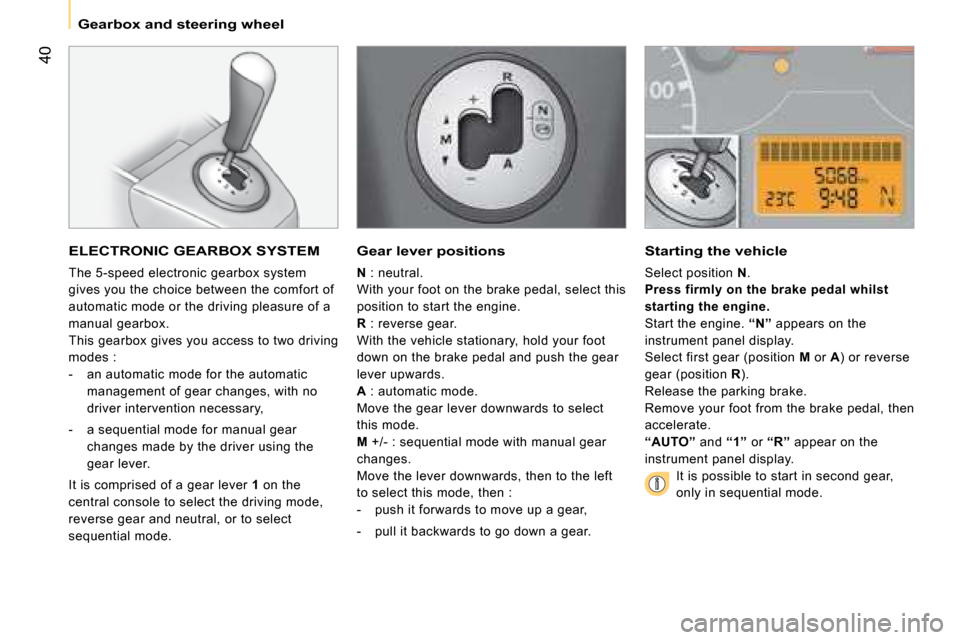
40
Gearbox and steering wheel
ELECTRONIC GEARBOX SYSTEM
The 5-speed electronic gearbox system
gives you the choice between the comfort of
automatic mode or the driving pleasure of a
manual gearbox.
This gearbox gives you access to two driving
modes :
- an automatic mode for the automatic
management of gear changes, with no
driver intervention necessary,
- a sequential mode for manual gear
changes made by the driver using the
gear lever.
It is comprised of a gear lever 1 on the
central console to select the driving mode,
reverse gear and neutral, or to select
sequential mode.
Gear lever positions
N : neutral.
With your foot on the brake pedal, select this
position to start the engine.
R : reverse gear.
With the vehicle stationary, hold your foot
down on the brake pedal and push the gear
lever upwards.
A : automatic mode.
Move the gear lever downwards to select
this mode.
M +/- : sequential mode with manual gear
changes.
Move the lever downwards, then to the left
to select this mode, then :
- push it forwards to move up a gear,
- pull it backwards to go down a gear.
Starting the vehicle
Select position N .
Press firmly on the brake pedal whilst
starting the engine.
Start the engine. “N” appears on the
instrument panel display.
Select first gear (position M or A) or reverse
gear (position R).
Release the parking brake.
Remove your foot from the brake pedal, then
accelerate.
“AUTO” and “1” or “R” appear on the
instrument panel display.
It is possible to start in second gear,
only in sequential mode.
Page 48 of 131
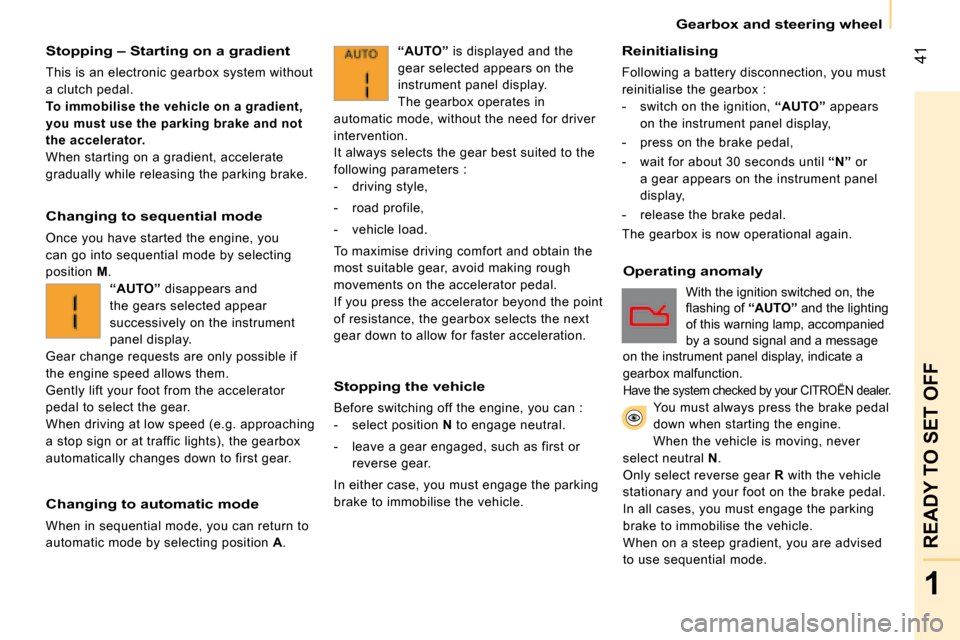
41
1
READY TO SET OFF
Gearbox and steering wheel
Stopping – Starting on a gradient
This is an electronic gearbox system without
a clutch pedal.
To immobilise the vehicle on a gradient,
you must use the parking brake and not
the accelerator.
When starting on a gradient, accelerate
gradually while releasing the parking brake.
Changing to sequential mode
Once you have started the engine, you
can go into sequential mode by selecting
position M.
“AUTO” disappears and
the gears selected appear
successively on the instrument
panel display.
Gear change requests are only possible if
the engine speed allows them.
Gently lift your foot from the accelerator
pedal to select the gear.
When driving at low speed (e.g. approaching
a stop sign or at traffic lights), the gearbox
automatically changes down to first gear.
Changing to automatic mode
When in sequential mode, you can return to
automatic mode by selecting position A.
Stopping the vehicle
Before switching off the engine, you can :
- select position N to engage neutral.
- leave a gear engaged, such as first or
reverse gear.
In either case, you must engage the parking
brake to immobilise the vehicle.
Reinitialising
Following a battery disconnection, you must
reinitialise the gearbox :
- switch on the ignition, “AUTO” appears
on the instrument panel display,
- press on the brake pedal,
- wait for about 30 seconds until “N” or
a gear appears on the instrument panel
display,
- release the brake pedal.
The gearbox is now operational again.
Operating anomaly
With the ignition switched on, the �fl� �a�s�h�i�n�g� �o�f� “AUTO” and the lighting of this warning lamp, accompanied by a sound signal and a message on the instrument panel display, indicate a
gearbox malfunction.
Have the system checked by your CITROËN dealer.
You must always press the brake pedal
down when starting the engine.
When the vehicle is moving, never
select neutral N.
Only select reverse gear R with the vehicle
stationary and your foot on the brake pedal.
In all cases, you must engage the parking
brake to immobilise the vehicle.
When on a steep gradient, you are advised
to use sequential mode.
“AUTO” is displayed and the
gear selected appears on the
instrument panel display.
The gearbox operates in
automatic mode, without the need for driver
intervention.
It always selects the gear best suited to the
following parameters :
- driving style,
- road profile,
- vehicle load.
To maximise driving comfort and obtain the
most suitable gear, avoid making rough
movements on the accelerator pedal.
If you press the accelerator beyond the point
of resistance, the gearbox selects the next
gear down to allow for faster acceleration.
Page 49 of 131
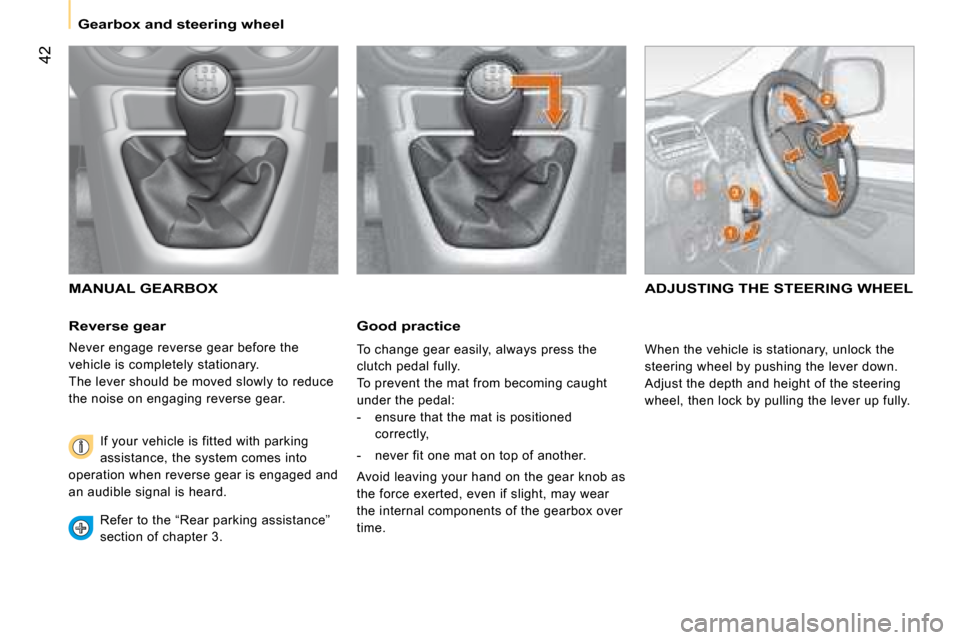
42
Gearbox and steering wheel
Reverse gear
Never engage reverse gear before the
vehicle is completely stationary.
The lever should be moved slowly to reduce
the noise on engaging reverse gear. If your vehicle is fitted with parking
assistance, the system comes into
operation when reverse gear is engaged and
an audible signal is heard.
Refer to the “Rear parking assistance”
section of chapter 3.
ADJUSTING THE STEERING WHEEL MANUAL GEARBOX
Good practice
When the vehicle is stationary, unlock the
steering wheel by pushing the lever down.
Adjust the depth and height of the steering
wheel, then lock by pulling the lever up fully.
To change gear easily, always press the
clutch pedal fully.
To prevent the mat from becoming caught
under the pedal:
- ensure that the mat is positioned
correctly,
- never fit one mat on top of another.
Avoid leaving your hand on the gear knob as
the force exerted, even if slight, may wear
the internal components of the gearbox over
time.
Page 60 of 131

54
Menu
MENU
This button enables you to:
- access the menus and sub-menus,
- confirm your selections within a menu,
- exit from the menus.
A long press enables you to return to the welcome screen.
This button enables you to:
- scroll up through a menu,
- increase a value.
This button enables you to:
- scroll down through a menu,
- decrease a value.
Menu... Press...
Sub-
menu...
Press... Select...
Confirm
and exit
Enables you to...
1 Speed Bleep ON Increase
Activate/deactivate the audible
signal indicating exceeding of the
programmed speed and select the
speed value.
Decrease
OFF
2 Activate
Trip B ON Activate
Display a second route “Trip B”.
OFF
� � �C�o�n�fi� �g�u�r�a�t�i�o�n� �-� �P�e�r�s�o�n�a�l�i�s�a�t�i�o�n�
Level 2 display:
The control pad located to the left of the
steering wheel provides access to display 2
menus which permit the personalisation of
some of your equipment.
Eight languages are offered: Italian, English,
German, French, Spanish, Portuguese,
Dutch and Turkish.
As a safety precaution, the menus can only
be accessed when the ignition is off (engine
off).
Refer to the corresponding line in the configurati on – personalisation table on the following
pages.
Page 85 of 131
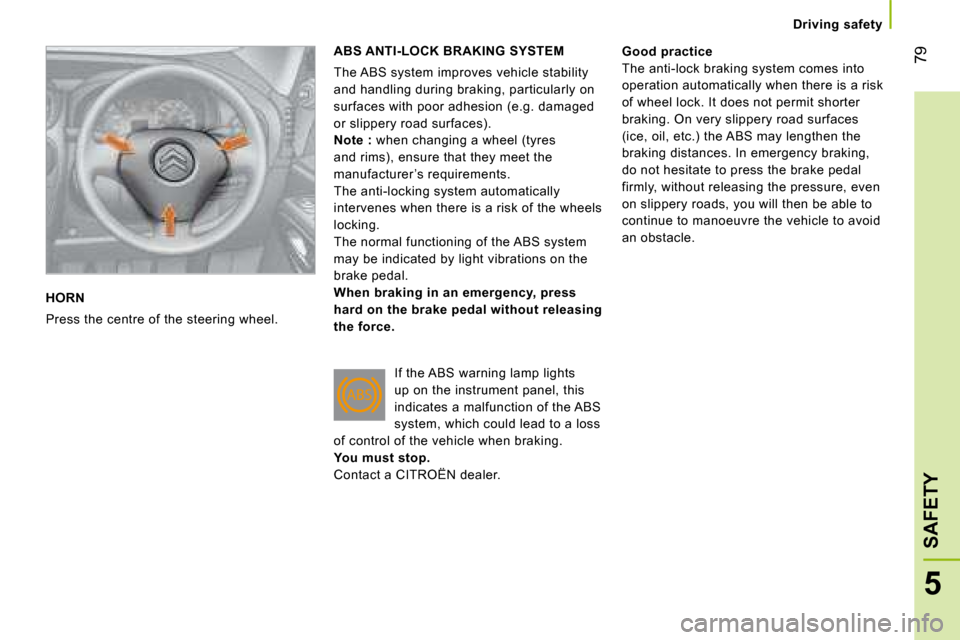
79
5
SAFETY
Driving safety
HORN
Press the centre of the steering wheel.
ABS ANTI-LOCK BRAKING SYSTEM
The ABS system improves vehicle stability
and handling during braking, particularly on
surfaces with poor adhesion (e.g. damaged
or slippery road surfaces).
Note : when changing a wheel (tyres
and rims), ensure that they meet the
manufacturer ’s requirements.
The anti-locking system automatically
intervenes when there is a risk of the wheels
locking.
The normal functioning of the ABS system
may be indicated by light vibrations on the
brake pedal.
When braking in an emergency, press
hard on the brake pedal without releasing
the force.
If the ABS warning lamp lights
up on the instrument panel, this
indicates a malfunction of the ABS
system, which could lead to a loss
of control of the vehicle when braking.
You must stop.
Contact a CITROËN dealer.
Good practice
The anti-lock braking system comes into
operation automatically when there is a risk
of wheel lock. It does not permit shorter
braking. On very slippery road surfaces
(ice, oil, etc.) the ABS may lengthen the
braking distances. In emergency braking,
do not hesitate to press the brake pedal
firmly, without releasing the pressure, even
on slippery roads, you will then be able to
continue to manoeuvre the vehicle to avoid
an obstacle.
Page 90 of 131

85
5
SAFETY
Air bags
For the air bags to be fully effective, observe the following safety rules:
Sit in a normal upright position.
Wear a correctly adjusted seat belt.
Do not leave anything between the
occupants and the air bags (a child, pet,
object...). This could hamper the operation
of the air bags or injure the occupants.
After an accident or if the vehicle has been
stolen or broken into, have the air bag
systems checked.
All work on the air bag systems is strictly
forbidden unless it is carried out by the
qualified personnel of a CITROËN dealer .
Even if all of the precautions mentioned are
observed, a risk of injury or of slight burns
to the head, chest or arms when an air bag
is triggered cannot be ruled out. In fact,
the bag inflates almost instantly (within a
few milliseconds) then deflates within the
same time, discharging the hot gas through
openings provided for this purpose.
Front air bags
Do not drive holding the steering wheel
by its spokes or resting your hands on the
centre part of the wheel.
Passengers must not place their feet on the
fascia.
Smoke as little as possible as deployment of
the air bags can cause burns or the risk of
injury from a cigarette or pipe.
Never remove or pierce the steering wheel
or hit it violently.
Side air bags
Only put approved covers on the seats.
These will not hinder the triggering of the
side air bags. Consult a CITROËN dealer .
Do not fix or glue anything to the seat backs.
This could cause injury to the chest or arms
when the side air bag inflates.
Do not sit with the upper part of the body
any nearer to the door than necessary.
Page 92 of 131
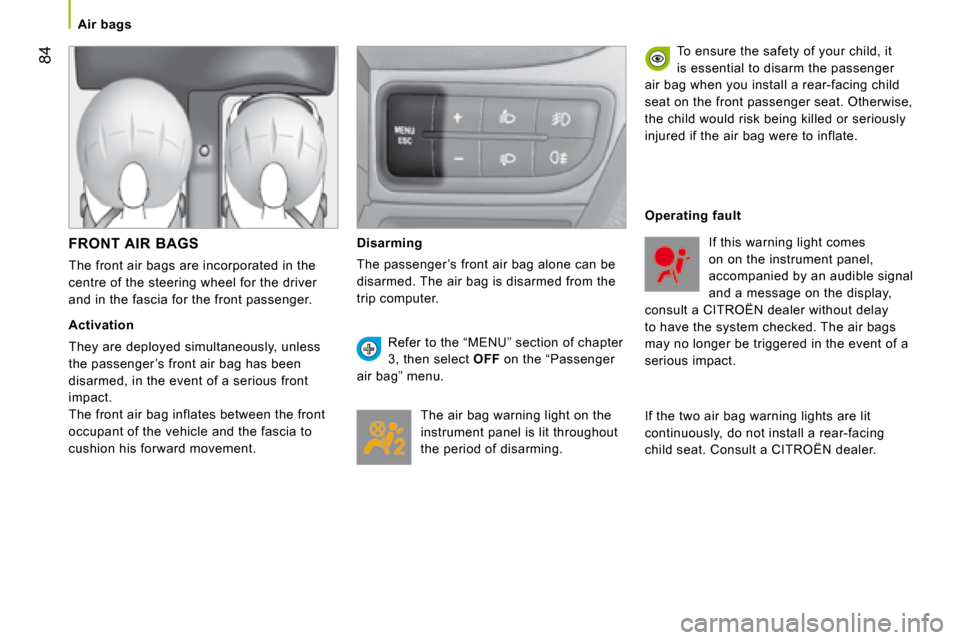
84
Air bags
FRONT AIR BAGS
The front air bags are incorporated in the
centre of the steering wheel for the driver
and in the fascia for the front passenger.
Activation
They are deployed simultaneously, unless
the passenger ’s front air bag has been
disarmed, in the event of a serious front
impact.
The front air bag inflates between the front
occupant of the vehicle and the fascia to
cushion his forward movement.
Disarming
The passenger ’s front air bag alone can be
disarmed. The air bag is disarmed from the
trip computer. The air bag warning light on the
instrument panel is lit throughout
the period of disarming. To ensure the safety of your child, it
is essential to disarm the passenger
air bag when you install a rear-facing child
seat on the front passenger seat. Otherwise,
the child would risk being killed or seriously
injured if the air bag were to inflate.
Refer to the “MENU” section of chapter
3, then select OFF on the “Passenger
air bag” menu.
Operating fault
If the two air bag warning lights are lit
continuously, do not install a rear-facing
child seat. Consult a CITROËN dealer . If this warning light comes
on on the instrument panel,
accompanied by an audible signal
and a message on the display,
consult a CITROËN dealer without delay
to have the system checked. The air bags
may no longer be triggered in the event of a
serious impact.
Page 93 of 131

85
5
SAFETY
Air bags
For the air bags to be fully effective, observe the following safety rules:
Sit in a normal upright position.
Wear a correctly adjusted seat belt.
Do not leave anything between the
occupants and the air bags (a child, pet,
object...). This could hamper the operation
of the air bags or injure the occupants.
After an accident or if the vehicle has been
stolen or broken into, have the air bag
systems checked.
All work on the air bag systems is strictly
forbidden unless it is carried out by the
qualified personnel of a CITROËN dealer .
Even if all of the precautions mentioned are
observed, a risk of injury or of slight burns
to the head, chest or arms when an air bag
is triggered cannot be ruled out. In fact,
the bag inflates almost instantly (within a
few milliseconds) then deflates within the
same time, discharging the hot gas through
openings provided for this purpose.
Front air bags
Do not drive holding the steering wheel
by its spokes or resting your hands on the
centre part of the wheel.
Passengers must not place their feet on the
fascia.
Smoke as little as possible as deployment of
the air bags can cause burns or the risk of
injury from a cigarette or pipe.
Never remove or pierce the steering wheel
or hit it violently.
Side air bags
Only put approved covers on the seats.
These will not hinder the triggering of the
side air bags. Consult a CITROËN dealer .
Do not fix or glue anything to the seat backs.
This could cause injury to the chest or arms
when the side air bag inflates.
Do not sit with the upper part of the body
any nearer to the door than necessary.
Page 123 of 131

112
Having your vehicle towed
BEING TOWED
Without lifting (four wheels on the ground)
You must always use a towbar.
From the front
The removable towing eye is located in the
tool kit behind the driver ’s seat (Van) or
behind the rear benchseat (Combi).
Unclip the cover using a flat tool.
Screw the removable towing eye in fully.
From the rear
Hook the bar onto the rigid eye located
under the bumper.
With lifting (2 wheels only on the ground)
It is preferable to lift the vehicle using
professional lifting equipment. When being towed with the engine
off, there is no braking or steering
assistance.